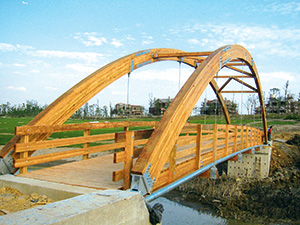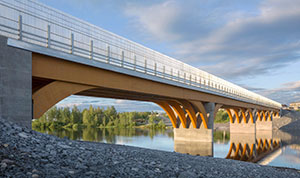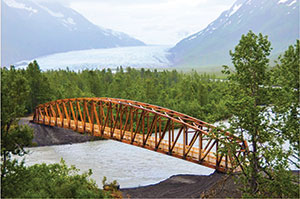 Glulam products, when manufactured with waterproof adhesives and pressure-preservative treatments, can be used in exposed applications such as bridges, utility poles and crossarms, and docks. Glulam beams are used in pedestrian and light vehicular applications, such as stream crossings on golf courses and in parks. They are also used in larger highway and railroad bridges. Designs range from straight girders to soaring arches. In all of these applications, the strength and stiffness of glulam give builders and designers more design versatility than they have with other structural products.
Glulam products, when manufactured with waterproof adhesives and pressure-preservative treatments, can be used in exposed applications such as bridges, utility poles and crossarms, and docks. Glulam beams are used in pedestrian and light vehicular applications, such as stream crossings on golf courses and in parks. They are also used in larger highway and railroad bridges. Designs range from straight girders to soaring arches. In all of these applications, the strength and stiffness of glulam give builders and designers more design versatility than they have with other structural products.
 Mistissini Bridge in Quebec Features Glulam Beams and CLT Panels
Mistissini Bridge in Quebec Features Glulam Beams and CLT Panels
The Mistissini Bridge, completed in June 2014, is one of Canada’s most significant wooden bridges.
The 160-meter-long glulam bridge crosses the Uupaachikus Pass, west of Mistissini, Quebec, creating an access point for residential expansion, permitting gravel to be sourced from a quarry, and expanding economic opportunities for the Cree Nation of Mistissini. Designed by Stantec, the bridge was constructed using laminated wood in a series of semi-continuous arches and glulam girders.
The Mistissini Bridge designers faced significant challenges. The bridge not only needed to provide an environmentally sustainable option with a negative carbon footprint, but it also needed to withstand the severe weather conditions of Northern Quebec. To address these challenges, laminated wood was chosen.
The bridge features locally sourced cross-laminated timber panels and glulam girders and panels. It has a steel guardrail and a steel plate with Bimagrip covering the wood walkway. A bituminous coating, several sheets of membrane, and marine plywood protect the bridge deck from water damage.
Using glulam beams made it possible to eliminate expansion joints on the bridge, giving the structure durability. All of the bridge bearings are fixed, which distributes the seismic effects over all foundation units, and reduces cost. “The bridge reflects nature around Mistissini,” said Denis Lefebvre, a senior associate and director of expertise, bridges and works of art out of the Stantec office in Longueuil, Quebec. “Constructing a wood bridge is more symbolic to the community than other kinds of bridges, such as steel or concrete.”

Glulam Timber Truss Bridge Spans Remote River
The Placer River Pedestrian Bridge, completed in July 2013, is the longest clear-span glulam timber truss bridge in North America. The 280-foot long camelback bridge is located in Chugach National Forest in Alaska at the Spencer Glacier Whistle Stop, one of five stops planned along a new railway in Alaska’s National Forests and Parks. Designed by Western Wood Structures, the bridge was constructed with preservative-treated Douglas-fir glulam trusses, Alaskan Yellow Cedar decking, and steel connectors.
The Placer River Pedestrian Bridge faced unique design challenges. Aesthetically, the US Forest Service wanted the bridge to evoke a look and feel reminiscent of an early 20th century railroad camp. At the same time, the backcountry bridge’s design had to not only withstand extreme weather, but also be placed high enough to avoid collisions with icebergs and ice floes from nearby Spencer Glacier. Sitting 25 feet above the waters of the Placer River, the bridge design meets every requirement for appearance, durability, and strength—and was achieved with cost-effective materials.
“People are pleased with the bridge—with the way it looks and with the way it fits in with the setting,” says Rod Dell’Andrea, a structural engineer for the USFS. “It’s truly a context-sensitive design and installation.”
Read more in the APA Case Study: Placer River Trail Bridge, Form Q110.